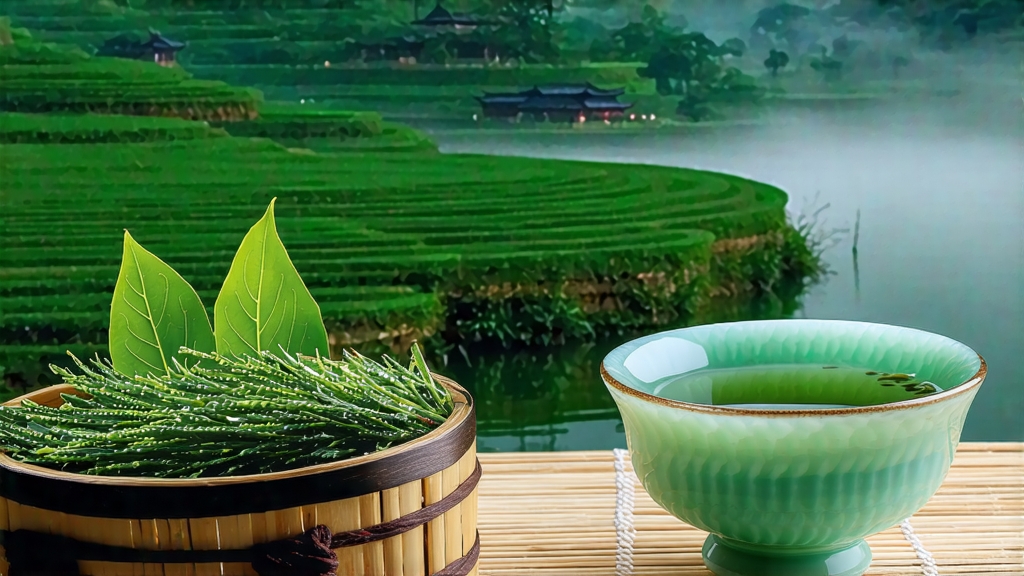
Longjing, literally “Dragon-Well,” is the most celebrated among China’s more than one thousand green-tea styles. Its fame rests not on legend alone but on a convergence of soil, micro-climate, cultivar, and centuries-old craft that turns a single spring bud into a cup of liquid jade. To understand Longjing is to glimpse the Chinese conviction that tea is agriculture, poetry, and philosophy pressed into one fragrant leaf.
History: From Imperial Tribute to Global Icon
The earliest written record appears in the Tang Dynasty (618-907) treatise “Classic of Tea,” yet Longjing’s ascendancy began when the Qianlong Emperor (r. 1735-1796) visited West Lake during a southern inspection tour. Local chronicles relate that the emperor was so enamored of the tea plucked at Lion Peak (Shi Feng) that he pocketed a handful of leaves, forgot them in his sleeve, and later bestowed imperial status on the village wells whose water he used to brew the forgotten gift. Whether apocryphal or not, the story secured Longjing’s place as gong cha—tribute tea—sent annually to the Forbidden City. By the late nineteenth century it was already exported through Hangzhou’s silk-trading houses, and in 1915 it won gold at the Panama-Pacific International Exposition. Today, West Lake Longjing is protected by a national-origin designation comparable to Champagne in France, and its spring auction prices can exceed USD 2,000 per 500 g for pre-Qingming lots picked before April 5.
Terroir and Cultivars: Why West Lake Matters
The lake’s north-western hills form an amphitheater that traps morning mist and softens the fierce Jiangnan sun. Acidic, well-drained quartz-sandstone soils, rich in selenium and barium, force the roots to dive deep, concentrating amino acids—especially L-theanine—in the buds. Four traditional cultivars dominate:
- Qunti Zhong (heirloom shrub, small leaves, high fragrance)
- Longjing #43 (modern clonal selection, early budding, uniform emerald color)
- Wuniuzao (even earlier, but lighter aroma, often blended)
- Jiu Keng Qunti (old mountain stock, rare, pronounced orchid note)
Within the 168 km² protected zone, five micro-villages are ranked like Burgundy crus: Shi Feng (Lion Peak), Mei Jia Wu, Weng Jia Shan, Longjing Village, and Hu Pao (Tiger Running Spring). Shi Feng, highest in altitude and shrouded in cloud, yields teas with the sharpest chestnut-sweet finish and a signature “ivory-yellow” liquor when brewed.
Harvest Calendar: The 24 Solar Terms in a Leaf
Plucking follows the lunisolar calendar more closely than the Gregorian.
- Pre-Qingming (before April 5): one bud plus half-open leaf, 2.0–2.5 cm, 60,000 buds per 500 g; amino-acid content above 4 %, polyphenols below 18 %, giving mellow sweetness.
- Before Grain Rain (April 20): one bud plus one full leaf, 3 cm; stronger, slightly astringent.
- Spring tail (early May): one bud plus two leaves; destined for restaurant grade.
On the eve of Qingming, pickers climb the terraces at dawn wearing bamboo hats but no gloves—skin contact is believed to bruise the bud. Leaves are placed in shallow bamboo baskets lined with gauze to prevent compression oxidation.
Craft: The Eight Motions of Hand-Firing
Longjing’s kill-green step is unique among Chinese greens for being conducted dry in a cast-iron wok rather than steamed or baked. A master chao cha shi (“tea-frying master”) may train ten years before being allowed to solo. The wok is pre-heated to 280 °C, then cooled to 80 °C within seconds by flicking water; 250 g of fresh leaves are tossed using eight wrist motions:
- Tiao (lifting)
- Da (light tapping)
- Da (re-pressing)
- Shua (brushing against wok wall)
- Nie (pinching to flatten)
- Tui (pushing into fold)
- Kou (curling edge)
- Feng (final sealing of aroma)